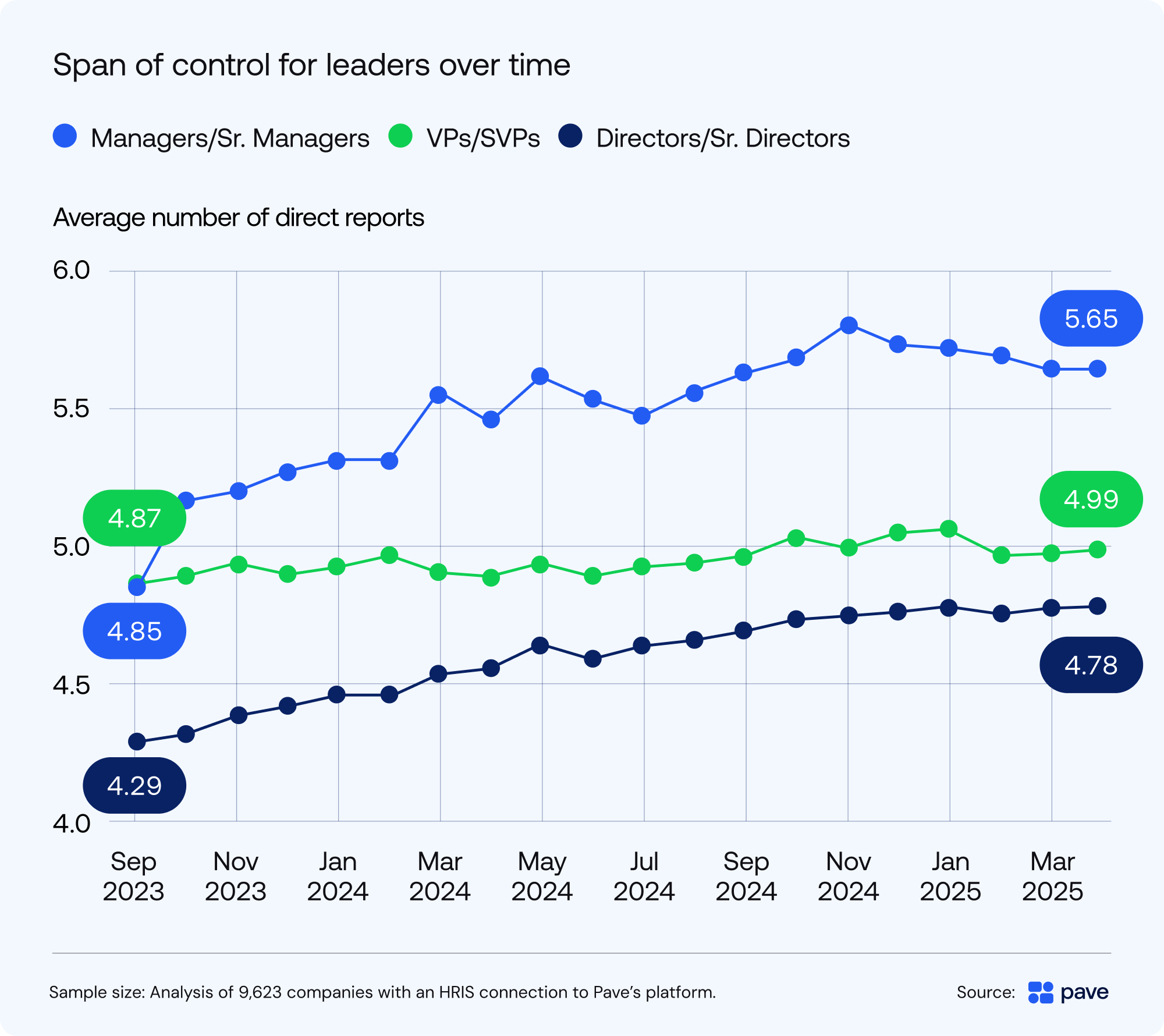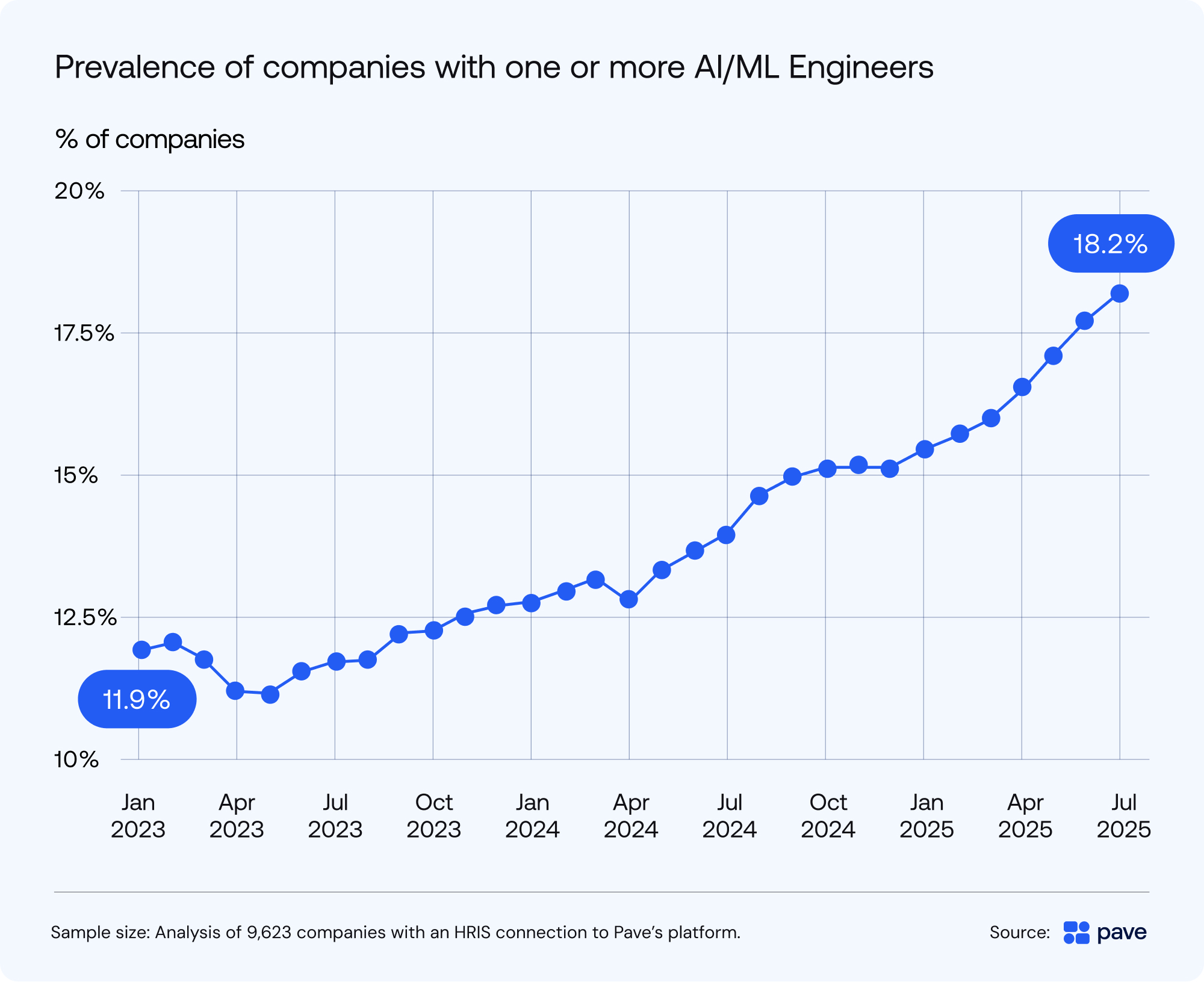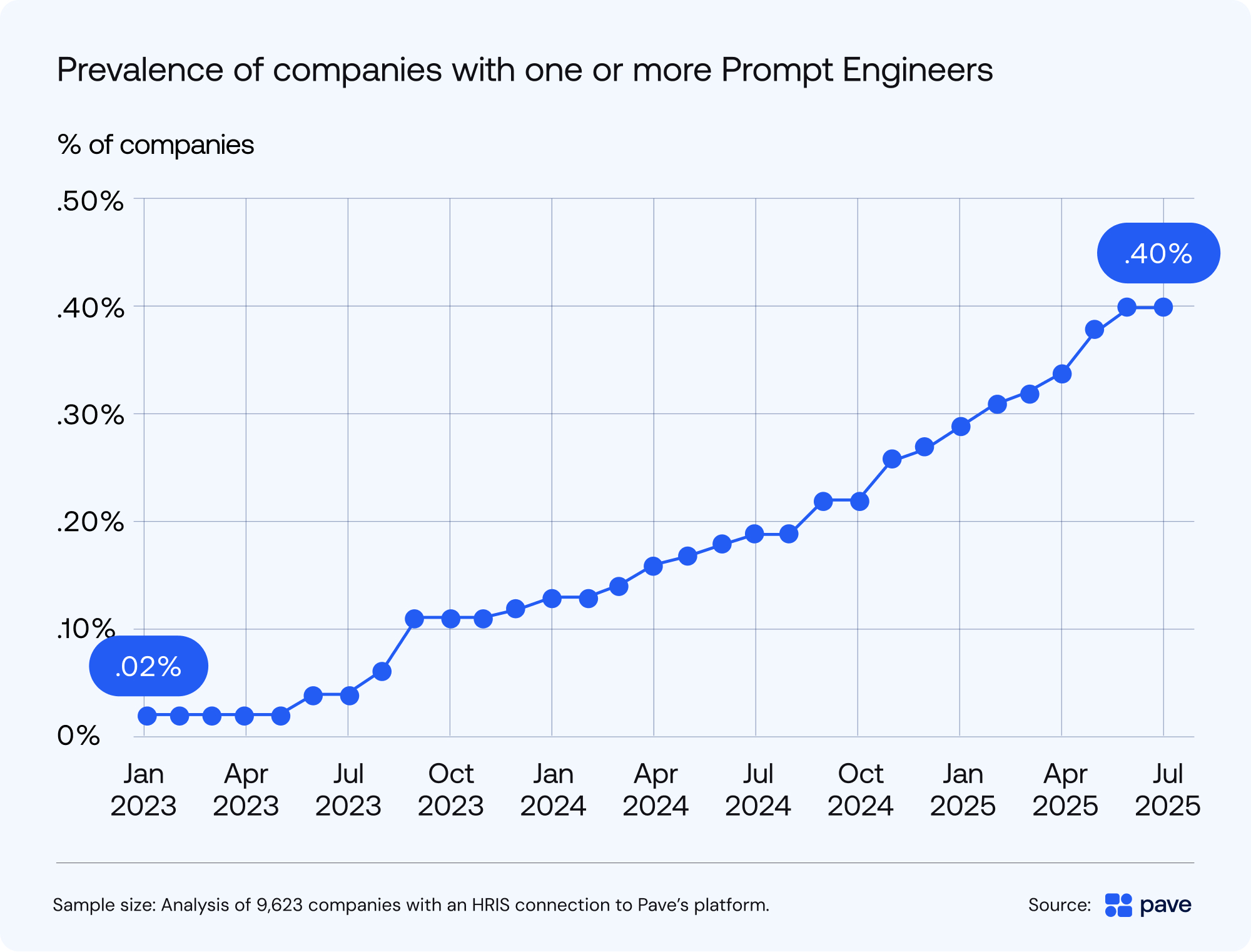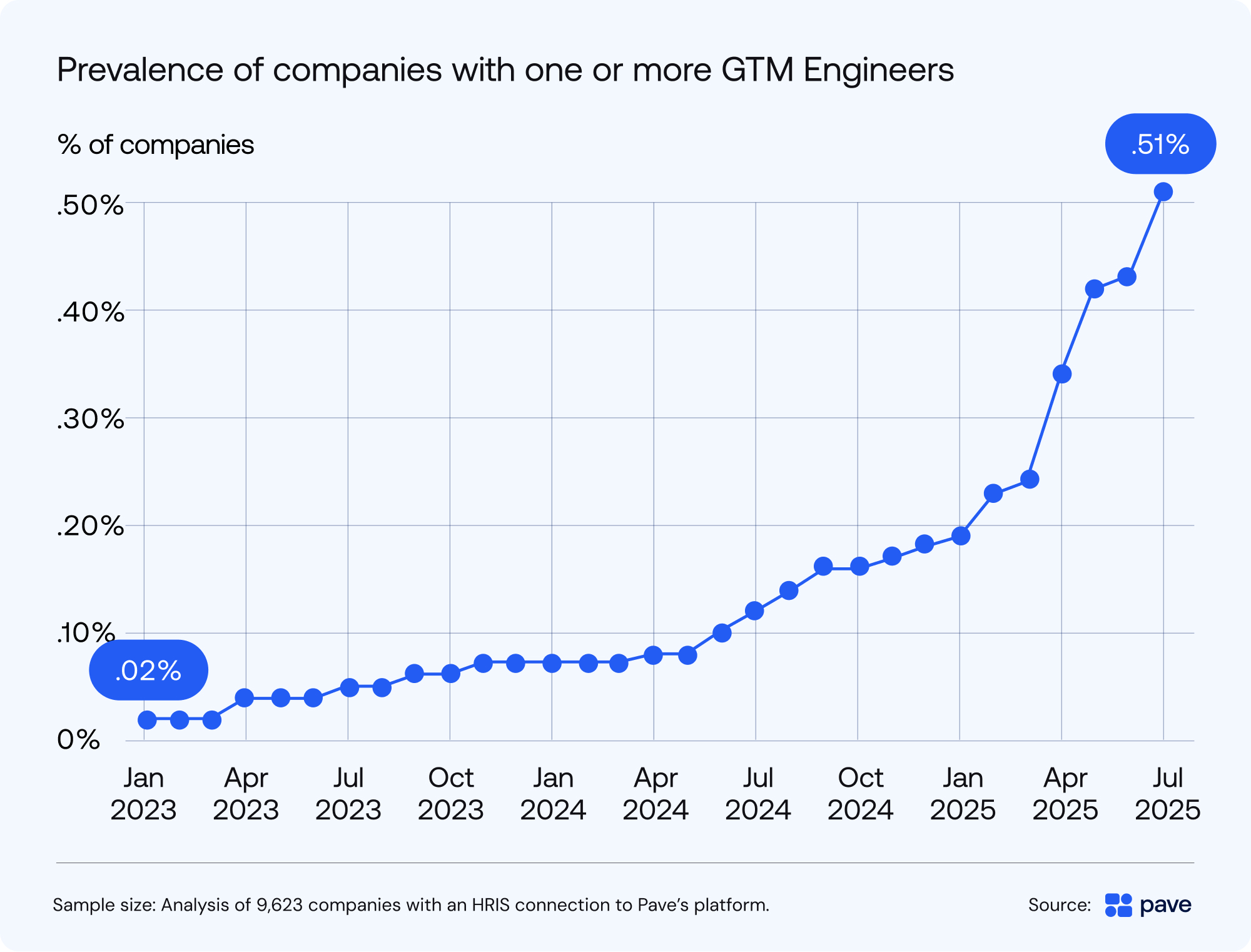Key Findings
- Between January 2023 and July 2025, the percentage of employees between the ages of 21 and 25 at large public technology companies has been cut in half.
- Employees in management roles are taking on more direct reports as executives seek efficiency gains from investments in artificial intelligence (AI).
- Jobs that once served as key pipelines for talent development, such as Sales Development Representatives, are disappearing. Meanwhile, jobs like GTM Engineer and Prompt Engineer are still nascent, but growing fast.
If you speak to recent college graduates, you’ll hear a common refrain: getting a job is really tough, especially the type of job they imagined getting when they started university four years ago.
A key culprit: artificial intelligence (AI). This new technology is quickly disrupting the workforce, and young professionals are suffering the consequences, especially at technology companies.
According to new research from Pave, a compensation intelligence platform that collects real-time pay and workforce data from thousands of companies, the number of 21- to 25-year-olds employed by technology and technology-adjacent firms (e.g., FinTech, HealthTech, etc.) is shrinking. At a time when a new generation of workers should be starting to make its mark in the world of business, this cohort is launching with more of a whimper than a bang.
The Young Professional Workforce Is Shrinking
As more CEOs publicly disclose their efforts to reduce headcount in favor of AI investments, Pave’s data science team set out to assess the impact of AI on the workforce. The first step in this effort was to examine the ages of more than 120,000 employees at large public technology companies to test the theory that younger employees in entry-level jobs will be hit first by the adoption of AI.
The results turned out as expected. In January 2023, employees between the ages of 21 and 25 made up 15.0% of the workforce at large public technology firms. However, by July 2025, people in the same age range only accounted for 6.8% of employees. Instead of growing, the population of young workers at these companies has been cut by more than half.
With companies like Alphabet, Amazon, Meta, and Microsoft announcing plans to spend more than $320 billion on AI in 2025, up from $230 billion in 2024, the pace at which AI replaces entry-level tasks will only accelerate, potentially closing the door on a new generation of professional workers.
The story is similar, but less severe at private technology companies. Here, Pave examined more than 900,000 employees. In January 2023, people between the ages of 21 and 25 made up 9.3% of the workforce, and as of July 2025, this number was also down to 6.8%.
.jpg)
As these shifts happen, the average age of the workforce is getting older. At large public technology companies, the average age of all employees increased from 34.3 years to 39.4 years between January 2023 and July 2025. Over the same timeframe, the average age of all employees at private technology companies increased from 35.1 years to 36.6 years.
Disappearing Sales Development Jobs
Few job families exemplify this trend better than Sales Development Representatives, Business Development Representatives, and Lead Development Representatives, collectively labeled here as “SDR” roles.
Historically, SDR roles served as a gateway for new college graduates into lucrative sales positions. If you proved yourself as an SDR by making thousands of cold calls and learning the basics of selling, you could advance. However, when Pave examined the prevalence of employees with SDR-related job titles, the data shows these jobs are steadily disappearing.
Back in January 2023, 1.98% of all people in Pave’s dataset were SDRs. However, by August 2025, this figure dropped to 1.45% of all employees. On the surface, this may seem like a small change, but in absolute terms, this shift represents thousands fewer SDR jobs. Over time, this trend will dramatically impact the talent pipeline into more senior sales positions.

Growing Workloads for People Managers
For more seasoned mid-career professionals and people managers, the story is different, but not necessarily good news. Their jobs are not disappearing at the same rate as many entry-level roles, but their workloads are increasing as business leaders deploy AI as a means to eliminate layers of middle management and drive efficiency gains.
To assess this trend, Pave examined span of control benchmarks—a measure of how many people report directly to managers. Among 180,000 managers, directors, and executives tracked over an 18-month period across a consistent set of technology companies, spans of control are climbing.
As the chart below illustrates, between September 2023 and April 2025, the average span of control for managers and senior managers grew from 4.85 to 5.65 direct reports, a 16.6% increase. Over the same period, the average span of control for directors and senior directors grew from 4.30 to 4.79 direct reports, an 11.4% increase. For vice presidents and senior vice presidents, the average span of control grew from 4.87 to 4.99 direct reports, a 2.5% increase.

Korn Ferry’s 2025 Workforce Survey adds credence to these findings, with “41% of surveyed employees reporting their organization has slashed management layers, resulting in less time for strategic planning, collaboration among their peers, and communication,” as workloads increase.
AI is Creating Some New Opportunities
Given the data above, the question then becomes: Are there any bright spots in the workforce? Are some jobs taking off as AI adoption increases? Yes, and this isn’t just true for Artificial Intelligence (AI) and Machine Learning (ML) Engineers (as shown in the chart below). The prevalence of AI and ML engineering roles, including AI Research Scientists, is certainly increasing, but several emerging roles are rapidly becoming more commonplace.

Let’s start by exploring Prompt Engineers, people who specialize in effectively using AI language models. While some will debate the value and long-term staying power of this role, for now the prevalence of this still-nascent job is increasing. When Pave examined all companies connected to its database, the prevalence of companies with at least one Prompt Engineer grew from 0.02% in January 2023 to 0.40% in July 2025. While the absolute number of people in this role is still very low, the prevalence of this job is growing quickly relative to others.

The rate of growth for Go-To-Market (GTM) Engineers is even faster. This so-called “hot job” is taking off as companies work to incorporate AI applications into their sales and marketing technology ecosystems. Again, among all companies connected to Pave’s database, the prevalence of companies with at least one GTM Engineer grew from 0.02% in January 2023 to 0.51% in July 2025, with a clear spike occurring at the start of this year.

Bottom-Up Transformation
When you put all this data together, it strongly suggests AI is transforming the composition of the workforce from the bottom up. As the quality of AI applications improves and tools get “smarter,” the impact of AI will continue to accelerate up the ranks.
Today, entry-level professionals have fewer opportunities, and managers and directors are expected to do more in the form of managing more people. Tomorrow, there may be far fewer managers and so on. Increasingly, the challenge for recent college graduates and younger professionals is finding niches of career growth where AI is creating new opportunities for people to make an impact. Learning how to use, deploy, and refine AI applications, as evidenced by the rise of Prompt Engineers and GTM Engineers, is gaining momentum as the wave of the future.
Alex is the General Manager for Pave's Market Data product and the firm's Vice President of Marketing and Strategy. He has more than two decades of experience in total rewards, including 10 years working at Aon plc developing, commercializing, and marketing the Radford Survey platform.






.jpg)
